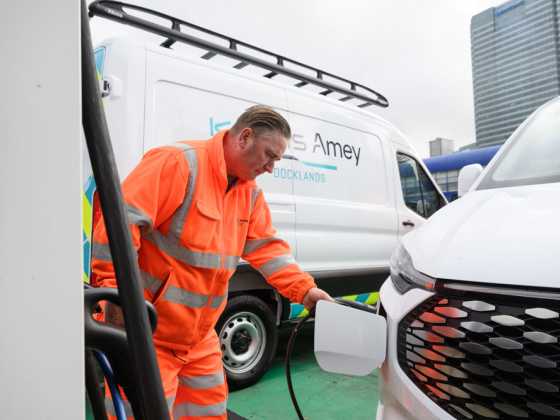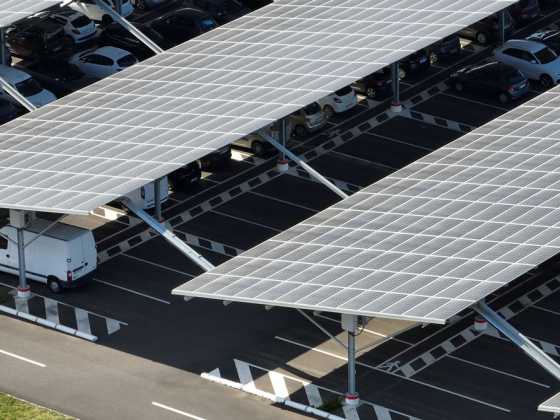A guide to installing charging infrastructure

From power requirements to landlord permissions, installing fleet, workplace or depot charging infrastructure needs careful consideration. Here’s what you need to know
When considering electric vehicles and assessing whether or not you need charging infrastructure installed at the workplace, it’s important to examine your fleet’s operational requirements. Can vehicles potentially charge at home or on the public network? Do you run ‘back to base’ operations when vehicles can charge at night? Or do you run a 24/7 service which will need a rapid DC charging for quick top ups?
If it’s decided that you need to install charging infrastructure on site, there are many points to contemplate. Firstly, you’ll need to understand your power availability. This involves finding out the size of your agreed supply capacity (ASC) from your DNO, how much of that power you use, and what spare capacity remains for EV chargers.
This process is vital so you do not exceed your supply and risk a power outage.
If your site does have power limitations, there are ways to get grid connection upgrades via your district network operator, although this is an expensive move.
Other ways include using smart chargers with load balancing capabilities, or having the ability to generate your own power, such as solar, used with energy storage.
Load balancing systems/software will use real time energy monitoring to change the maximum amount of energy that chargers can use based on availability and requirement of the site.
An important part of the EV installation process is getting a site survey. This will assess how EV charging can be installed and engineers will typically visit the site to assess power requirements and if any groundworks would need to be done.
A good chargepoint installer will be happy to do the above as part of their service.
If you don’t own the property, you will need to obtain consent from the landlord for chargepoints to be installed. This can be time consuming and may involve legal work, so it’s worth beginning these conversations as early as you can.
Understanding charging speeds
You will need to understand the different charging speeds to understand what is the most appropriate for you fleet.
Fast charging has speeds of between 7kWh – 25kWh and is suited to destination, fleet, and overnight depot charging.
Rapid charging has speeds of 50kWh – 100kWh and can be used for quick turnaround charging.
Ultra-Rapid has speeds of 150kWh – 400kWh and is suited for public charging hubs, car parks, short-stay destinations and electric HGVs.
It’s also helpful to understand the difference between AC and DC charging.
A chargepoint with alternating current (AC) will get the alternating current from the grid and pass this on to the vehicle to convert to direct current and feed into the electric vehicle’s battery. The vehicle dictates the maximum AC charging rate, typically 7kW, 11kW and 22kW (though there are few vehicles capable at the highest rate).
DC charge points have the converter within the charger which means that the power is converted to DC before it is passed to the EV. The size of the converters will be much bigger than those inside a vehicle and therefore this results in a faster charge time.
Back office systems
When choosing your chargepoint installer, it’s important to find out about their back office portals. A good back office system will allow you to monitor charging times, speeds, payments and conduct CO2 reporting.
It’s also important to look at what aftercare the chargepoint operator offers for service and maintenance, including callouts for repair.
Get help with funding
There are various government grants for installing chargepoints, such as the The Workplace Charging Scheme (WCS) and The EV infrastructure grant for staff and fleets.
The Workplace Charging Scheme is open to businesses, charities, public sector organisations and small accommodation businesses, such as hotels or campsites (with 249 employees or less). Both have funding confirmed until 31 March 2025.
The WCS grant covers up to 75 per cent of the total costs of the purchase and installation of EV chargepoints and is capped at a maximum of £350 per sockets and 40 sockets across all sites per applicant.
The organisation requiring the chargepoints must apply for the grant, and if they are successful, will be emailed a voucher code which can then be given to the chargepoint installer. Once the chargepoints have been installed, the installer will claim the grant.
The EV infrastructure grant for staff and fleets is for small-to-medium-sized businesses in the UK with 249 employees or less. It can help cover the cost of wider building and installation work, such as wiring and posts, that’s needed to install multiple chargepoint sockets. The work can be for sockets that are to be installed now and in the future.
The scheme covers up to 75 per cent of the cost of the work. There is a limit of £15,000 per grant and you can get up to £350 per chargepoint socket installed and £500 per parking space.






